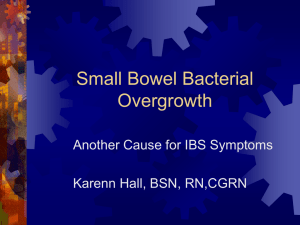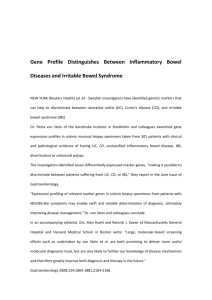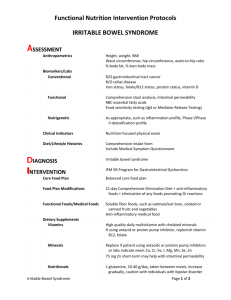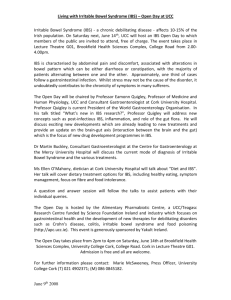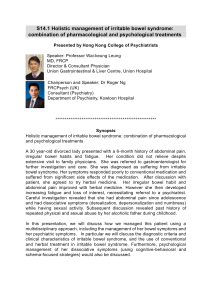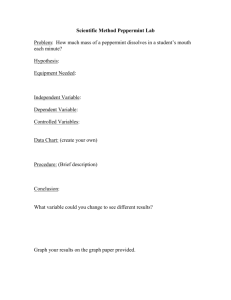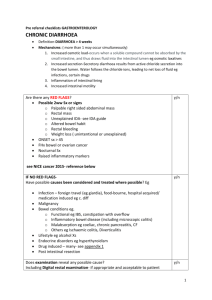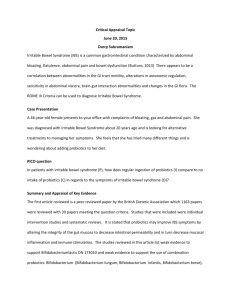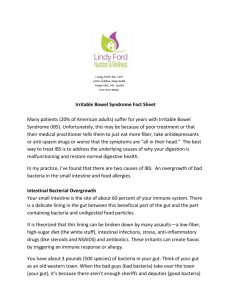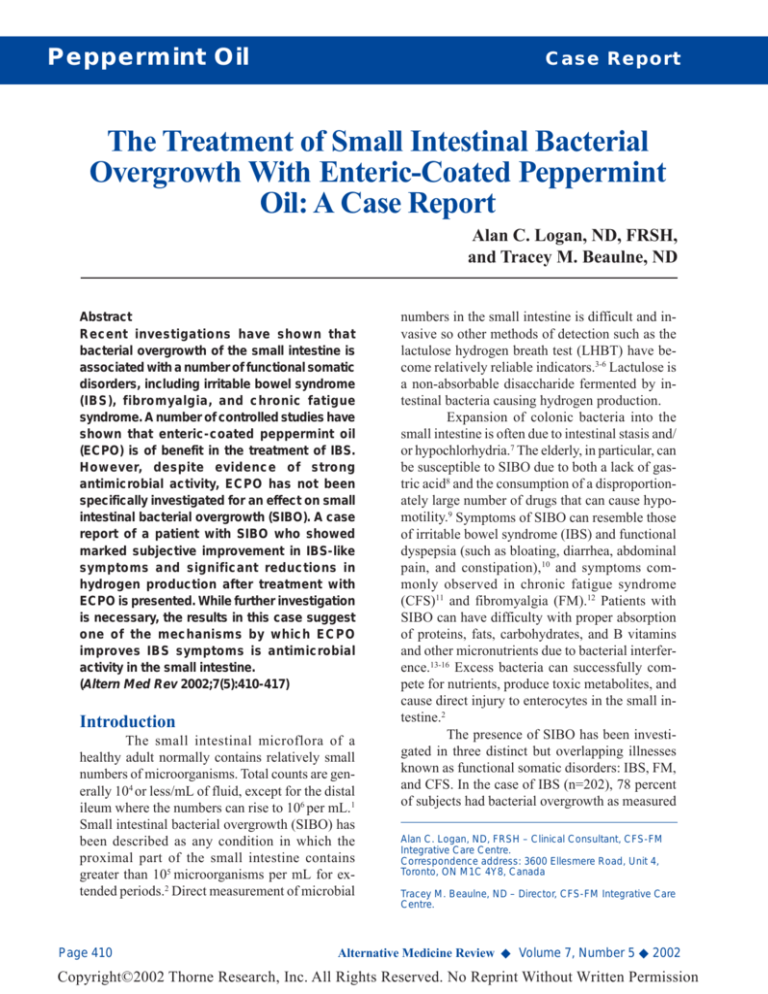
Peppermint Oil
Case Report
The Treatment of Small Intestinal Bacterial
Overgrowth With Enteric-Coated Peppermint
Oil: A Case Report
Alan C. Logan, ND, FRSH,
and Tracey M. Beaulne, ND
Abstract
Recent investigations have shown that
bacterial overgrowth of the small intestine is
associated with a number of functional somatic
disorders, including irritable bowel syndrome
(IBS), fibromyalgia, and chronic fatigue
syndrome. A number of controlled studies have
shown that enteric-coated peppermint oil
(ECPO) is of benefit in the treatment of IBS.
However, despite evidence of strong
antimicrobial activity, ECPO has not been
specifically investigated for an effect on small
intestinal bacterial overgrowth (SIBO). A case
report of a patient with SIBO who showed
marked subjective improvement in IBS-like
symptoms and significant reductions in
hydrogen production after treatment with
ECPO is presented. While further investigation
is necessary, the results in this case suggest
one of the mechanisms by which ECPO
improves IBS symptoms is antimicrobial
activity in the small intestine.
(Altern Med Rev 2002;7(5):410-417)
Introduction
The small intestinal microflora of a
healthy adult normally contains relatively small
numbers of microorganisms. Total counts are generally 104 or less/mL of fluid, except for the distal
ileum where the numbers can rise to 106 per mL.1
Small intestinal bacterial overgrowth (SIBO) has
been described as any condition in which the
proximal part of the small intestine contains
greater than 105 microorganisms per mL for extended periods.2 Direct measurement of microbial
Page 410
numbers in the small intestine is difficult and invasive so other methods of detection such as the
lactulose hydrogen breath test (LHBT) have become relatively reliable indicators.3-6 Lactulose is
a non-absorbable disaccharide fermented by intestinal bacteria causing hydrogen production.
Expansion of colonic bacteria into the
small intestine is often due to intestinal stasis and/
or hypochlorhydria.7 The elderly, in particular, can
be susceptible to SIBO due to both a lack of gastric acid8 and the consumption of a disproportionately large number of drugs that can cause hypomotility.9 Symptoms of SIBO can resemble those
of irritable bowel syndrome (IBS) and functional
dyspepsia (such as bloating, diarrhea, abdominal
pain, and constipation),10 and symptoms commonly observed in chronic fatigue syndrome
(CFS)11 and fibromyalgia (FM).12 Patients with
SIBO can have difficulty with proper absorption
of proteins, fats, carbohydrates, and B vitamins
and other micronutrients due to bacterial interference.13-16 Excess bacteria can successfully compete for nutrients, produce toxic metabolites, and
cause direct injury to enterocytes in the small intestine.2
The presence of SIBO has been investigated in three distinct but overlapping illnesses
known as functional somatic disorders: IBS, FM,
and CFS. In the case of IBS (n=202), 78 percent
of subjects had bacterial overgrowth as measured
Alan C. Logan, ND, FRSH – Clinical Consultant, CFS-FM
Integrative Care Centre.
Correspondence address: 3600 Ellesmere Road, Unit 4,
Toronto, ON M1C 4Y8, Canada
Tracey M. Beaulne, ND – Director, CFS-FM Integrative Care
Centre.
Alternative Medicine Review ◆ Volume 7, Number 5 ◆ 2002
Copyright©2002 Thorne Research, Inc. All Rights Reserved. No Reprint Without Written Permission
Case Report
Peppermint Oil
by the LHBT.10 In a separate study, FM patients
overgrowth may play a direct role in altering
(n=123) had the same high rate of SIBO at 78 perintestinal transit via an effect on the migrating
cent,17 and in a third study 77 percent of CFS pamyoelectric complex, which controls transit time.26
18
tients (n=31) were diagnosed with SIBO. In all
three studies antibiotics were administered to paThe Potential of Enteric-Coated
tients with SIBO, leading to marked subjective
Peppermint Oil
improvements in about half of those with overThere are a number of studies demonstratgrowth. Eradication of bacteria was measured by
ing
that
aromatic
oils from plants can act as broadLHBT approximately 10 days after a course of
spectrum
antimicrobial
agents.27-29 Peppermint oil
antibiotics (most often Ciprofloxacin 500 mg po
is one such agent that has been shown, at least in
bid or Flagyl 500 mg po tid, for 10 days). Sucvitro, to inhibit the growth of at least 22 bacterial
cessful eradication of SIBO was significantly corstrains, including gram-positive cocci and rods and
related with a reduction in gastrointestinal comgram-negative rods.30-33 While menthol, the key
plaints. Interestingly, in the CFS study, eradicaactive ingredient in peppermint oil (constituting
tion led to significant improvements in memory,
36%), is effective against a number of bacteria,
concentration, pain, and depression. Decreased
the entire peppermint oil is a more effective antinutrient levels have been observed among CFS
microbial agent than menthol alone.31 In addition
patients19 and SIBO may
be a contributing factor.
The similar rates
of SIBO across all three
patient populations are
not entirely surprising
Table 1. Irritable Bowel Syndrome: Diagnostic Criteria
given the clinical
overlaps. 20 Research
shows that 92 percent of
IBS Diagnostic Criteria
CFS patients and 77
A total of 12 weeks in the preceding year (need not be
percent of FM patients
21
consecutive) where abdominal discomfort or pain is experienced
have a history of IBS.
and accompanied by at least two of the following:
Patients reporting chronic
fatigue
(not
the
1. Relieved with defecation
syndrome) have a high
2. Onset associated with a change in frequency of stool
rate of IBS (73%),
3. Onset associated with a change in form or appearance of stool
according to a one-year
retrospective study.22 A
Supportive Symptoms Include:
separate study found that
70 percent of FM patients
• More than three bowel movements per day or less than three
had IBS and 65 percent of
per week
IBS patients met FM
• Loose or hard stools
• Straining, a sense of urgency, or a feeling of incomplete bowel
criteria, leading the
movement
authors to suggest they
•
Passing
of mucus
are different expressions
•
Abdominal
distension or bloating
of a common pathogenic
23
process. Indeed, a delay
in gastric emptying has
Thompson WG, Longstreth GF, Drossman DA, et al. Functional bowel
been observed in both
disorders and functional abdominal pain. Gut 1999;45 (Suppl 2):II43- II47.
IBS 24
and
CFS. 25
Intestinal microbial
Alternative Medicine Review ◆ Volume 7, Number 5 ◆ 2002
Page 411
Copyright©2002 Thorne Research, Inc. All Rights Reserved. No Reprint Without Written Permission
Peppermint Oil
Case Report
Figure 1. Hydrogen/Methane Production (ppm)
Pre- and Post-treatment
70
60
50
40
30
20
10
0
Fasting
20 min
60 min
similar to those of IBS, including
abdominal pain, nausea, bloating,
gas, and indigestion. The clinical
overlap of dyspepsia with IBS is well
described39 and many of the symptoms are similar to SIBO. Clinical
trials using enteric-coated peppermint and caraway oil vs. placebo have
documented remarkable results in the
treatment of FD, with reductions in
pain, heaviness, pressure, and fullness.40-43 In all studies, the dose administered was 90 mg peppermint oil
and 50 mg caraway oil twice daily;
the combination was reported as safe
and well tolerated.
The beneficial effects of peppermint oil on gastrointestinal symptoms led the authors to consider its
usefulness in the treatment of a patient who presented with IBS-like
symptoms.
Case Report
D.B. is a 29-year-old female
who presented to the clinic with a
Pre-treatment
Post-treatment
diagnosis (one week earlier) of IBS
from her primary care medical doctor.
Investigation confirmed the
symptoms D.B. was experiencing the
to inhibiting the growth of bacteria, peppermint
last 18 months fit the Rome II criteria (Table 1)
oil has a bactericidal activity against pathogenic
for IBS.44 The main symptoms described were
bacteria, including E. coli 015:H7, H. pylori, and
diarrhea alternating with constipation
S. enteritidis. The antibacterial activity was ap(constipation predominant), abdominal bloating,
parent even when tested against pathogenic, antipain (particularly post-prandial), non-acid
biotic-resistant strains.34
eructation, and fatigue. Given the research
Enteric-coated peppermint oil (ECPO) has
connecting SIBO and IBS, the decision was made
been the subject of much research in the area of
to have D.B. perform an LHBT according to
IBS and functional dyspepsia (FD). A number of
established laboratory procedures (Can Lab
double-blind, placebo-controlled studies have
Services, West Vancouver, BC).
shown that ECPO can effectively treat the sympAfter completion of the LHBT, but withtoms of IBS, including a reduction in the severity
out waiting for the results, D.B. was placed on a
of pain.35-38 In most of these studies, the standard
20-day course of ECPO at a dose of 0.2 mL three
dose given was 0.2 mL ECPO three times daily.
times daily. No dietary modifications or other
Peppermint oil has also been used, in comforms of treatment were initiated. Six days after
bination with caraway oil, to treat the symptoms
the ECPO course was completed, D.B. repeated
of functional dyspepsia. The symptoms of FD are
the LHBT.
Page 412
Alternative Medicine Review ◆ Volume 7, Number 5 ◆ 2002
Copyright©2002 Thorne Research, Inc. All Rights Reserved. No Reprint Without Written Permission
Peppermint Oil
Case Report
Results of the initial LHBT indicated D.B.
Discussion
was in a severe state of SIBO. The initial baseline
This case supports the use of ECPO in the
(after fasting) level of hydrogen (H2) and methtreatment of IBS. Studies examining the effects
ane (CH4) was 31 ppm, rising to 70 ppm after one
of peppermint oil on bowel motility have shown
hour. Fasting breath hydrogen of healthy adults
that mechanisms may include calcium channel
and children is approximately 7 ppm and less than
blocking on a local level, causing smooth muscle
one percent have a breath hydrogen exceeding 30
relaxation.47-50 Peppermint oil can lead to reducppm.45 A fasting level of H2 and CH4 of greater than
tions in colonic spasm during colonoscopy51 and
20 is considered elevated46 and D.B.’s change in
barium enema.52 Based on the results presented,
baseline gases through one hour, at 39 ppm is conanother mechanism of action that can be proposed
sidered severe. The follow-up LHBT (posttreatment) revealed significant reductions
in H 2 /CH 4 production at baseline and
through one hour. Follow-up baseline levels were 25 ppm, still considered elevated
but reduced to 25 percent over normal upTable 2. Pre-treatment H2 and CH4 (ppm)
per limit vs. 55 percent at initial testing. At
20 minutes the amount of hydrogen produced was almost half that of the initial test20 min.
60 min.
Minutes
Fasting
ing. Another decrease was observed in the
60-minute H2/CH4 production at 48 ppm, a
39
68
Hydrogen
28
32-percent reduction. The change from
4
2
Methane
3
baseline through 60 minutes was 23 ppm,
a 42-percent reduction from initial testing,
43
70
Total
31
placing D.B. into the mildly elevated laboratory range. The breath test results are outlined in Tables 2 and 3 and summarized in
Figure 1. Hydrogen production after sixty
in IBS is an antimicrobial effect in the small intesminutes becomes more reflective of colonic bactine. It is clear that altered gastric motility can set
teria and is therefore not included in data collecthe stage for SIBO, but altered flora may also intion.
fluence gastric motility26 and subjective pain.53-54
These objective improvements
were accompanied by reports from the patient indicating marked improvements in
bowel function. D.B. reported decreased
bloating, pain, and eructation, and increased
frequency of normal bowel movements. PaTable 3. Post-treatment H2 and CH4 (ppm)
tient reported that most symptom improvements were observed after 10 days of treatment, and there was no aggravation of
60 min.
20 min.
Minutes
Fasting
symptoms when the ECPO course was con46
20
cluded.
Hydrogen
22
Methane
3
2
2
Total
25
22
48
Alternative Medicine Review ◆ Volume 7, Number 5 ◆ 2002
Page 413
Copyright©2002 Thorne Research, Inc. All Rights Reserved. No Reprint Without Written Permission
Peppermint Oil
Case Report
In this case, through the follow-up LHBT,
only the mono-therapy of ECPO was used. Although an antimicrobial effect was apparent in the
follow-up LHBT results, the patient was still in
the mildly elevated laboratory range. The therapeutic value of berberine as an antimicrobial
agent55 and the ability of hydrochloric acid (HCl)
to prevent and treat bacterial overgrowth56 have
previously been described. The addition of berberine and HCl would likely provide an additive
effect to ECPO.
Although peppermint oil has not specifically been investigated for its inhibition or bactericidal effect against beneficial flora, this should
be assumed due to the effect on both gram-positive and -negative bacteria. After the follow-up
LHBT, D.B. was placed on Lactobacillus acidophilus and Bifidobacterium lactis. Interestingly,
various strains of Lactobacillus and
Bifidobactrium have been used to successfully
treat SIBO57,58 and IBS.59-61 The importance of restoring normal intestinal flora cannot be over-emphasized. Antimicrobials are known to have
marked62 and long-term effects on bowel flora.63
Recent studies have shown that antibiotic use is
actually associated with IBS onset and functional
bowel symptoms, possibly due to alterations in
bowel flora.64,65
IBS is the most common digestive tract
disorder; symptoms consistent with IBS criteria
affect almost a quarter of the general population
over a lifetime.66 It has been estimated there are
between 2.4 and 3.5 million annual visits to U.S.
physicians by patients with IBS;67 an editorial in
the journal Gastroenterology describes IBS as a
“multibillion dollar problem.”68 Patients with functional somatic disorders frequently visit practitioners of complementary and alternative medicine
(CAM).69,70 Patients with IBS are twice as likely
to visit a CAM practitioner than the general population.71 CAM practitioners should be aware of the
effects of SIBO, a condition that is often overlooked,2 particularly in the elderly. SIBO may
become increasingly common, as acid-blocking
medications, which can cause bacterial overgrowth,72-74 are self-prescribed. Patients with SIBO
Page 414
are at increased risk for reduced bone mineral density due to interference with mineral absorption.75
This is of particular significance in patients with
CFS and FM where physical activity is already
decreased.
ECPO may provide cost-effective relief
of gastrointestinal complaints in patients with certain functional somatic disorders, including IBS,
CFS, and FM. The presence of SIBO should be
investigated if possible, and proper steps taken to
reduce bacterial numbers. Further research is necessary to evaluate the use of ECPO as an in vivo
antimicrobial agent.
References
1.
2.
3.
4.
5.
6.
7.
8.
9.
10.
Mitsuoka T. Recent trends in research on
intestinal flora. Bifido Microflora 1982;1:3-24.
Toskes PP. Bacterial overgrowth of the
gastrointestinal tract. Adv Intern Med
1993;38:387-407.
Metz G, Gassull MA, Drasar BS, et al. Breathhydrogen test for small-intestinal bacterial
colonisation. Lancet 1976;1:668-669.
Rhodes JM, Middleton P, Jewell DP. The
lactulose hydrogen breath test as a diagnostic
test for small-bowel bacterial overgrowth.
Scand J Gastroenterol 1979;14:333-336.
King CE, Toskes PP. Breath tests in the
diagnosis of small intestine bacterial overgrowth. Crit Rev Clin Lab Sci 1984;21:269281.
Wang J, Bei L, Pan G. Lactulose hydrogen
breath test in small intestinal bacterial overgrowth. Zhonghua Nei Ke Za Zhi 1995;34:381384. [Article in Chinese]
Holt PR. Diarrhea and malabsorption in the
elderly. Gastroenterol Clin North Am
1990;19:345-359.
Saltzman JR, Russell RM. The aging gut.
Nutritional issues. Gastroenterol Clin North
Am 1998;27:309-324.
Ratnaike RN, Jones TE. Mechanisms of druginduced diarrhoea in the elderly. Drugs Aging
1998;13:245-253.
Pimentel M, Chow EJ, Lin HC. Eradication of
small intestinal bacterial overgrowth reduces
symptoms of irritable bowel syndrome. Am J
Gastroenterol 2000;95:3503-3506.
Alternative Medicine Review ◆ Volume 7, Number 5 ◆ 2002
Copyright©2002 Thorne Research, Inc. All Rights Reserved. No Reprint Without Written Permission
Peppermint Oil
Case Report
11.
12.
13.
14.
15.
16.
17.
18.
19.
20.
21.
22.
23.
24.
Komaroff AL, Fagioli LR, Geiger AM, et al.
An examination of the working case definition
of chronic fatigue syndrome. Am J Med
1996;100:56-64.
Waylonis GW, Heck W. Fibromyalgia syndrome. New associations. Am J Phys Med
Rehabil 1992;71:343-348.
Donaldson RM Jr. Role of enteric microorganisms in malabsorption. Fed Proc
1967;26:1426-1431.
King CE, Toskes PP. Small intestine bacterial
overgrowth. Gastroenterology 1979;76:10351055.
Simon GL, Gorbach SL. Intestinal flora in
health and disease. Gastroenterology
1984;86:174-193.
Tabaqchali S. The pathophysiological role of
small intestinal bacterial flora. Scand J
Gastroenterol Suppl 1970;6:139-163.
Pimentel M, Chow EJ, Hallegua D, et al.
Small intestinal bacterial overgrowth: a
possible association with fibromyalgia. J
Musculoskelet Pain 2001;9:107-113.
Pimentel M, Hallegua D, Chow EJ, et al.
Eradication of small intestinal bacterial
overgrowth decreases symptoms in chronic
fatigue syndrome: a double blind, randomized
study. Gastroenterology 2000;118:A414.
Werbach MR. Nutritional strategies for
treating chronic fatigue syndrome. Altern Med
Rev 2000;5:93-108.
Wessely S, Nimnuan C, Sharpe M. Functional
somatic syndromes: one or many? Lancet
1999;354:936-939.
Aaron LA, Burke MM, Buchwald D. Overlapping conditions among patients with chronic
fatigue syndrome, fibromyalgia, and temporomandibular disorder. Arch Intern Med
2000;160:221-227.
Gomborone JE, Gorard DA, Dewsnap PA, et
al. Prevalence of irritable bowel syndrome in
chronic fatigue. J R Coll Physicians Lond
1996;30:512-513.
Veale D, Kavanagh G, Fielding JF, Fitzgerald
O. Primary fibromyalgia and the irritable
bowel syndrome: different expressions of a
common pathogenetic process. Br J Rheumatol
1991;30:220-222.
Caballero-Plasencia AM, Valenzuela-Barranco
M, Herrerias-Gutierrez JM, Esteban-Carretero
JM. Altered gastric emptying in patients with
irritable bowel syndrome. Eur J Nucl Med
1999;26:404-409.
25.
26.
27.
28.
29.
30.
31.
32.
33.
34.
35.
36.
37.
Alternative Medicine Review ◆ Volume 7, Number 5 ◆ 2002
Burnet RB, Chatterton B. Gastrointestinal
symptoms and gastric emptying studies in
chronic fatigue syndrome. AHMF Clinical and
Scientific Meeting. Sydney, Australia. 2001.
Husebye E, Hellstrom PM, Sundler F, et al.
Influence of microbial species on small
intestinal myoelectric activity and transit in
germ-free rats. Am J Physiol Gastrointest Liver
Physiol 2001;280:G368-G380.
Moleyar V, Narasimham P. Antibacterial
activity of essential oil components. Int J Food
Microbiol 1992;16:337-342.
Delaquis PJ, Stanich K, Girard B, Mazza G.
Antimicrobial activity of individual and mixed
fractions of dill, cilantro, coriander and
eucalyptus essential oils. Int J Food Microbiol
2002;74:101-109.
Dorman HJ, Deans SG. Antimicrobial agents
from plants: antibacterial activity of plant
volatile oils. J Appl Microbiol 2000;88:308316.
Pattnaik S, Subramanyam VR, Kole C.
Antibacterial and antifungal activity of ten
essential oils in vitro. Microbios 1996;86:237246.
Pattnaik S, Subramanyam VR, Bapaji M, Kole
CR. Antibacterial and antifungal activity of
aromatic constituents of essential oils.
Microbios 1997;89:39-46.
Farag RS, Daw ZY, Hewedi FM, El-Baroty
GSA. Antimicrobial activity of some Egyptian
spice essential oils. J Food Prot 1989;52:665667.
Shapiro S, Meier A, Guggenheim B. The
antimicrobial activity of essential oils and
essential oil components toward oral bacteria.
Oral Microbiol Immunol 1994;9:202-208.
Imai H, Osawa K, Yasuda H, et al. Inhibition
by the essential oils of peppermint and
spearmint of the growth of pathogenic bacteria. Microbios 2001;106:31-39.
Rees WD, Evans BK, Rhodes J. Treating
irritable bowel syndrome with peppermint oil.
Br Med J 1979;2:835-836.
Dew MJ, Evans BK, Rhodes J. Peppermint oil
for the irritable bowel syndrome: a multicentre
trial. Br J Clin Pract 1984;38:394, 398.
Liu JH, Chen GH, Yeh HZ, et al. Entericcoated peppermint-oil capsules in the treatment of irritable bowel syndrome: a prospective, randomized trial. J Gastroenterol
1997;32:765-768.
Page 415
Copyright©2002 Thorne Research, Inc. All Rights Reserved. No Reprint Without Written Permission
Peppermint Oil
38.
39.
40.
41.
42.
43.
44.
45.
46.
47.
48.
49.
Page 416
Case Report
Kline RM, Kline JJ, Di Palma J, Barbero GJ.
Enteric-coated, pH-dependent peppermint oil
capsules for the treatment of irritable bowel
syndrome in children. J Pediatr 2001;138:125128.
Bytzer P, Talley NJ. Dyspepsia. Ann Intern
Med 2001;134:815-822.
May B, Kuntz HD, Kieser M, Kohler S.
Efficacy of a fixed peppermint oil/caraway oil
combination in non-ulcer dyspepsia.
Arzneimittelforschung 1996;46:1149-1153.
Freise J, Kohler S. Peppermint oil-caraway oil
fixed combination in non-ulcer dyspepsia –
comparison of the effects of enteric combinations. Pharmazie 1999;54:210-215. [Article in
German]
Madisch A, Heydenreich CJ, Wieland V, et al.
Treatment of functional dyspepsia with a fixed
peppermint oil and caraway oil combination
preparation as compared to cisapride. A
multicenter, reference-controlled double-blind
equivalence study. Arzneimittelforschung
1999;49:925-932.
May B, Kohler S, Schneider B. Efficacy and
tolerability of a fixed combination of peppermint oil and caraway oil in patients suffering
from functional dyspepsia. Aliment Pharmacol
Ther 2000;14:1671-1677.
Thompson WG, Longstreth GF, Drossman
DA, et al. Functional bowel disorders and
functional abdominal pain. Gut 1999;45
(Suppl 2):II43- II47.
Perman JA, Modler S, Barr RG, Rosenthal P.
Fasting breath hydrogen concentration: normal
values and clinical application. Gastroenterology 1984;87:1358-1363.
Joseph F Jr, Rosenberg AJ. Breath hydrogen
testing: diseased versus normal patients. J
Pediatr Gastroenterol Nutr 1988;7:787-788.
Taylor BA, Luscombe DK, Duthie HL.
Inhibitory effect of peppermint oil on gastrointestinal smooth muscle. Gut
1983;24:A992.
Taylor BA, Luscombe DK, Duthie HL.
Inhibitory effect of peppermint oil and menthol
on human isolated colon. Gut 1984;25:A1168A1169.
Hills JM, Aaronson PI. The mechanism of
action of peppermint oil on gastrointestinal
smooth muscle. An analysis using patch clamp
electrophysiology and isolated tissue pharmacology in rabbit and guinea pig. Gastroenterology 1991;101:55-65.
50.
51.
52.
53.
54.
55.
56.
57.
58.
59.
60.
Micklefield GH, Greving I, May B. Effects of
peppermint oil and caraway oil on gastroduodenal motility. Phytother Res
2000;14:20-23.
Leicester RJ, Hunt RH. Peppermint oil to
reduce colonic spasm during endoscopy.
Lancet 1982;2:989.
Jarvis LJ, Hogg H, Houghton CD. Topical
peppermint oil for the relief of colonic spasm
at barium enema. Clin Radiol 1992;46:435.
Gerards C, Leodolter A, Glasbrenner B,
Malfertheiner P. H. pylori infection and
visceral hypersensitivity in patients with
irritable bowel syndrome. Dig Dis
2001;19:170-173.
Gasbarrini A, De Luca A, Fiore G, et al.
Beneficial effects of Helicobacter pylori
eradication on migraine.
Hepatogastroenterology 1998;45:765-770.
Birdsall TC, Kelly GS. Berberine: therapeutic
potential of an alkaloid found in several
medicinal plants. Altern Med Rev 1997;2:94103.
Kelly GS. Hydrochloric acid: physiological
functions and clinical implications. Altern Med
Rev 1997;2:116-127.
Vanderhoof JA, Young RJ, Murray N,
Kaufman SS. Treatment strategies for small
bowel bacterial overgrowth in short bowel
syndrome. J Pediatr Gastroenterol Nutr
1998;27:155-160.
Kanamori Y, Hashizume K, Sugiyama M, et al.
Combination therapy with Bifidobacterium
breve, Lactobacillus casei, and
galactooligosaccharides dramatically improved
the intestinal function in a girl with short
bowel syndrome: a novel synbiotics therapy
for intestinal failure. Dig Dis Sci
2001;46:2010-2016.
Nobaek S, Johansson ML, Molin G, et al.
Alteration of intestinal microflora is associated
with reduction in abdominal bloating and pain
in patients with irritable bowel syndrome. Am
J Gastroenterol 2000;95:1231-1238.
Brigidi P, Vitali B, Swennen E, et al. Effects of
probiotic administration upon the composition
and enzymatic activity of human fecal
microbiota in patients with irritable bowel
syndrome or functional diarrhea. Res
Microbiol 2001;152:735-741.
Alternative Medicine Review ◆ Volume 7, Number 5 ◆ 2002
Copyright©2002 Thorne Research, Inc. All Rights Reserved. No Reprint Without Written Permission
Peppermint Oil
Case Report
61.
62.
63.
64.
65.
66.
67.
68.
69.
Niedzielin K, Kordecki H, Birkenfeld B. A
controlled, double-blind, randomized study on
the efficacy of Lactobacillus plantarum 299V
in patients with irritable bowel syndrome. Eur
J Gastroenterol Hepatol 2001;13:1143-1147.
Nord CE, Heimdahl A, Kager L. Antimicrobial
induced alterations of the human oropharyngeal and intestinal microflora. Scand J Infect
Dis 1986;49:64-72.
Mangin I, Bourget N, Bouhnik Y, et al.
Identification of Bifidobacterium strains by
rRNA gene restriction patterns. Appl Environ
Microbiol 1994;60:1451-1458.
Mendall MA, Kumar D. Antibiotic use,
childhood affluence and irritable bowel
syndrome (IBS). Eur J Gastroenterol Hepatol
1998;10:59-62.
Maxwell PR, Rink E, Kumar D, Mendall MA.
Antibiotics increase functional abdominal
symptoms. Am J Gastroenterol 2002;97:104108.
Jones R, Lydeard S. Irritable bowel syndrome
in the general population. BMJ 1992;304:8790.
Sandler RS. Epidemiology of irritable bowel
syndrome in the United States. Gastroenterology 1990;99:409-415.
Longstreth GF. Irritable bowel syndrome: a
multibillion-dollar problem. Gastroenterology
1995;109:2029-2031.
Bombardier CH, Buchwald D. Chronic
fatigue, chronic fatigue syndrome, and
fibromyalgia. Disability and health-care use.
Med Care 1996;34:924-930.
70.
71.
72.
73.
74.
75.
Alternative Medicine Review ◆ Volume 7, Number 5 ◆ 2002
Pioro-Boisset M, Esdaile JM, Fitzcharles MA.
Alternative medicine use in fibromyalgia
syndrome. Arthritis Care Res 1996;9:13-17.
Donker GA, Foets M, Spreeuwenberg P.
Patients with irritable bowel syndrome: health
status and use of health care services. Br J Gen
Pract 1999;49:787-792.
Ruddell WS, Axon AT, Findlay JM, et al.
Effect of cimetidine on the gastric bacterial
flora. Lancet 1980;1:672-674.
Ruddell WS, Losowsky MS. Severe diarrehoea
due to small intestinal colonisation during
cimetidine treatment. Br Med J 1980;281:273.
Deane S, Youngs D, Poxon V, et al. Cimetidine
and gastric microflora. Br J Surg 1980;67:371.
Di Stefano M, Graziamaria V, Malservisi S,
Corazza GR. Small intestine bacterial overgrowth and metabolic bone disease. Dig Dis
Sci 2001;46:1077-1082.
Page 417
Copyright©2002 Thorne Research, Inc. All Rights Reserved. No Reprint Without Written Permission

